My Arizona Fab Four Edible Mushrooms
Arizona is home to a vast number of mushroom producing fungi. Among them are many edible varieties. If your goal is to go beyond simple (and honorable) appreciation, and actually forage for edible mushrooms, you are in for a challenge. The challenge, of course, is correctly recognizing those suitable for the table from those suitable for a trip to the clinic. Amateur mycologists and serious foragers find the task of identification just as fun as the excursion itself. But amateur foragers are in a more difficult situation, and need a few "gimme" mushrooms to get them started.
This Arizona Fabulous Four page acts as a guide to some of the most easily recognized and most common edible mushrooms in the state. As a beginning forager, you are bound to encounter many, many varieties of mushrooms that you don't recognize. As time goes on your portfolio of recongizable mushrooms will increase. The most important factor in choosing mushrooms to bring back home is to be 100% certain of what you have before they hit the pan. The four edible mushrooms featured here should give any beginner a good start.
The Aspen Bolete
Leccinum insigne
The aspen bolete has a brown, domed cap, white to cream colored pores (darkening in age), and a distinctive white stem covered with scaly projections called scabers. There are many boletes that resemble the aspen bolete, but none with this combination of features. The aspen bolete associates specifically with Aspen, which is also a diagnostic feature (but less useful in mixed woods). When cut, the white flesh will slowly darken with a blue-black hue.
As can be deduced by its common name, the best place to look for aspen boletes is in aspen groves. They tend to prefer transition zones on the grove edge.
Aspen boletes are robust and survive handling well, although the flesh will darken from rough handling. The flesh is firm, and lends itself to a wide variety of preparation and cooking methods. The stem is much tougher than the cap, and is better for making stock. The aspen bolete dries especially well; the flesh darkens significantly, but is not adversely affected.
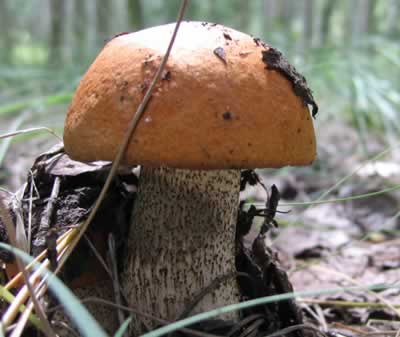
The Common Puffball
Lycoperdon pyriforme and Lycoperdon perlatum
The common puffball, or pear-shaped puffball, reaches a diameter of 1”-2”, and has a white, cream, or light tan surface. Many, but not all, have an ornamented surface. In its immature form, the flesh is firm but spongy, and rebounds from being squeezed. As it reaches maturity, the skin typically darkens, and the interior softens and eventually becomes a brown powdered mass of spores. Most puffballs are edible, but they must be young enough to have a pure white interior. Slice open all puffballs either in the field or after collecting. Beware of look-alike young mushroom “eggs”, which will reveal themselves when sliced open and inspected.
Puffballs are very common in woods, but can be found in a wide variety of other areas as well. Some types decompose wood, and can be found in large groups on well-rotted logs (especially moss-covered ones). Others tend to occur on the ground. In Arizona, expect to find puffballs in areas that experience good rainfall and have rich soil that retains moisture.
Puffballs have a soft texture and mild flavor, but absorb other flavors well. They are excellent sliced and sauteed with butter and a squeeze of lemon.
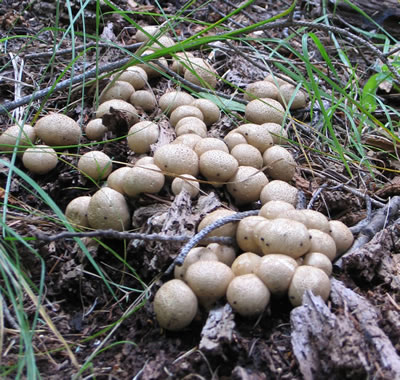
The Shaggy Mane
Coprinus comatus
The appearance of the shaggy mane is unmistakable: Tall, cylindrical, with a white, scaly surface. As the shaggy mane matures, the edge of the cap begins to deliquesce into a black, spore laden ink. It is important to note that other members of the “Inky Caps” share this trait, but only the shaggy mane has a tall, shaggy appearance. It is usually found in groups, and at various phases of maturity. Always look for adult specimens to ensure proper ID.
You can expect to find shaggy manes in many parts of Arizona that recieve decent rainfall and have rich soil that retains moisture. The best places to look are trails and gravel roads with a grassy buffer. Fields used by livestock can also be good producers. The shaggy mane is rarely found within a forest.
Only the immature, white shaggy manes should be collected. They will begin to deliquesce within 12 hours, so prepare them as soon as possible. Shaggy manes are fragile and contain a fair amount of water, so are best “sweated” in a saute pan and then sauteed with oil/butter or battered and fried.
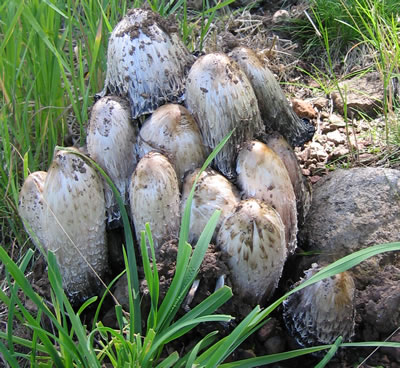
The Lobster Mushroom
Hypomyces lactiflorum
Lobster mushrooms are, as their name implies, brightly colored reddish-orange. Their general appearance is as a deformed flask. If you are searching for mushrooms, it will be impossible to miss lobster mushrooms unless they are completely covered in leaf litter. They are also especially firm and dense.
Lobster mushrooms are Russulas and Lactarius that have been parasitized (lobsterized?) by a microscopic ascomycete. This ascomycete, Hypomyces, catches the mushroom in its early development and transforms the tissues into its own. As a result of this transformation, the tissues become edible regardless of the mushroom's original chemistry.
You have a chance of finding lobster mushrooms wherever you find Russula and Lactarius. And where there is one transformed Russula, there is a good chance there are others. The best locations to find all of the above are typically around conifers in a mixed conifer forest. Another area that seems to be productive is transition spaces between Aspens and conifers.
Lobster mushrooms are often very dirty as they often mature partially underground. However, because they are so firm and do not have delicate gills, they handle washing well. The best way to prepare lobster mushrooms is to slice them thinly and sweat them in a saute pan. Their strong flavor is best accented by mild seasoning. One good preparation involves olive oil, white wine, and some ground nutmeg.
Take note: there are other members of Hypomyces that attack other mushrooms such as boletes, and there is also a variety that will turn Russulas green. None of these are colored red-orange and none are edible.
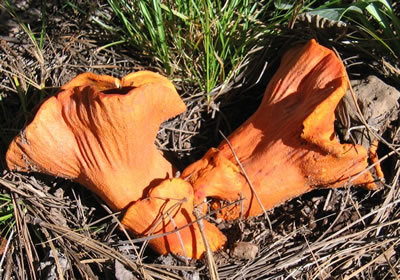
The brilliant orange, unmistakable lobster mushroom.
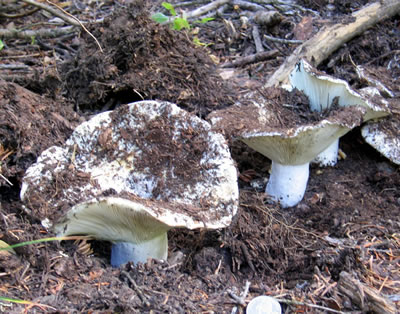
Russulas. These, and Lactarius, are the mushrooms that become "Lobsterized" by H. lactiflorum